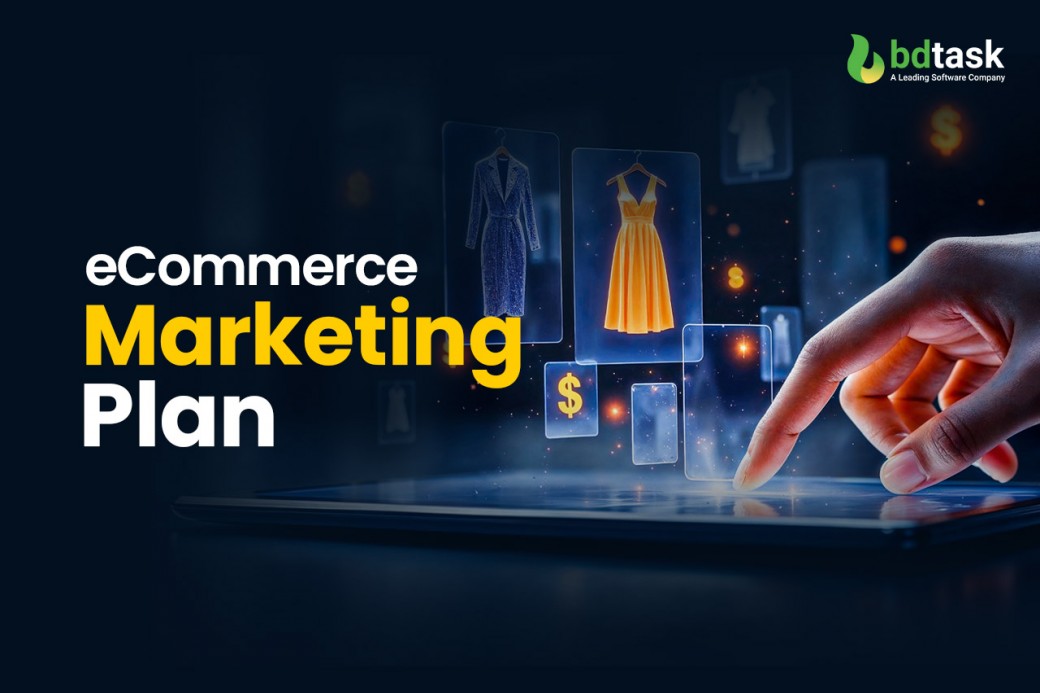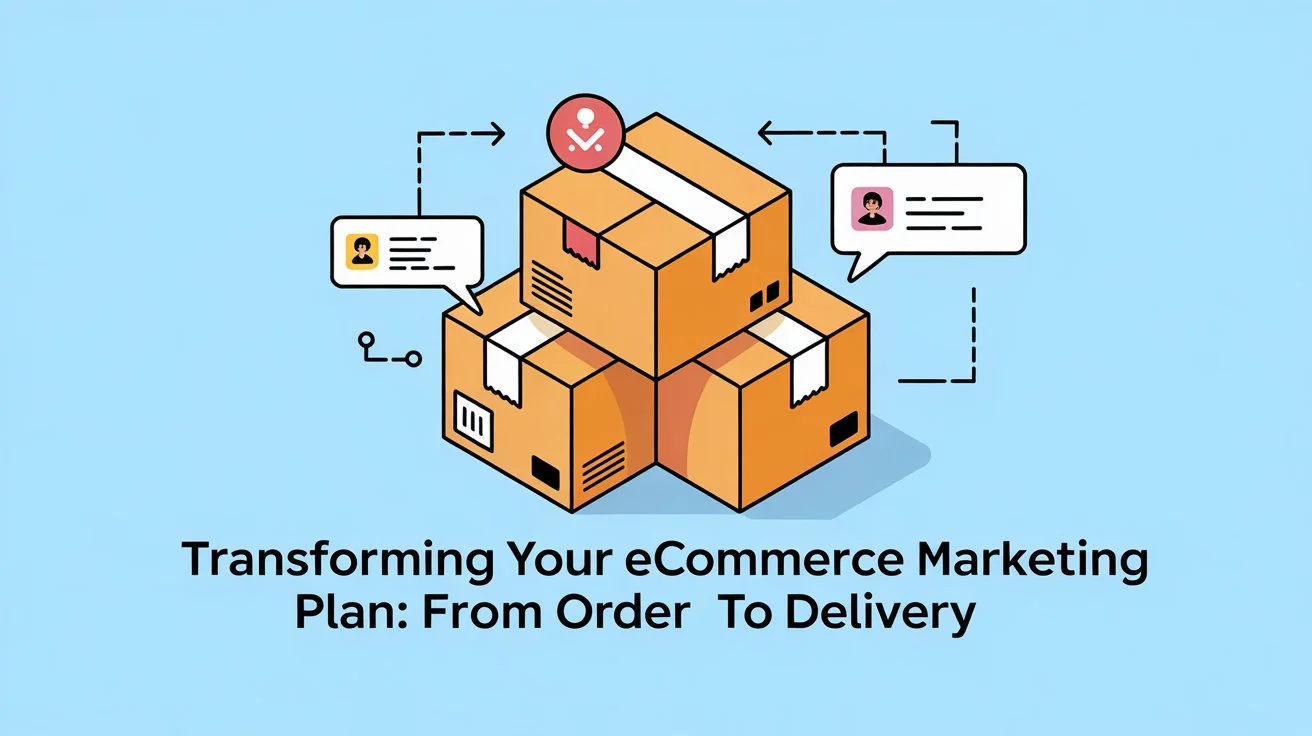Transforming Your eCommerce Marketing Plan: From Order to Delivery

For eCommerce businesses, the thing that reigns supreme is the customer experience. Improving the customer experience is the core of eCommerce businesses. You cannot ignore a single touchpoint. From the moment a customer discovers a product to its delivery, everything matters. From order placement to final delivery—can turn your ecommerce marketing plan into a seamless customer journey.
To get the attention of potential buyers and turn them into repeat customers, a strong marketing plan is needed. In this blog post, you’ll learn how to develop an ecommerce marketing plan for every stage of the business and customer lifecycle.
So, stick with us through the post if you also want to fine-tune your marketing plan and deliver outstanding customer experiences.
Let's bounce.
eCommerce Marketing Redefined
Many of today's eCommerce businesses are still operating on traditional models. We are talking about those in which marketing is all about getting the customers through the door. For this, they spent a handsome amount on advertisements, influencer saas partnerships, and discount offers.
The above-mentioned approach is good for boosting traffic and conversions. But you know what? This approach only scratches the surface of what modern eCommerce marketing can do, which many businesses are overlooking.
What is an eCommerce Market Plan?
eCommerce Marketing Plan - think of it like outlining strategies that help an online business increase its sales and brand awareness. The key focus in such marketing plans is on attracting, engaging, and converting customers.
To make a successful eCommerce marketing plan, businesses have to focus on certain essential components, including
- Target audience
- Marketing channels
- Tactics & strategies
- Budget
- Evaluation
Do not think of these plans as paper-only strategies. Implementing them in your business brings many benefits. For example, with the help of a well-defined eCommerce marketing plan, your business can:
- Drive more traffic, ultimately more sales
- Establish a positive brand image among potential customers
- Successfully retain existing customers
- Stay ahead of competitors in the market
What Businesses Are Overlooking?
A thing that we observed many of the eCommerce businesses are overlooking is the post-order marketing strategies. All of their focus is on pre-order marketing.
Once an order is placed by a customer, they start taking it as an operational concern and start neglecting the marketing here. This thing often leads the journey to:
- Slow order processing
- Vague shipping timelines
- Clunky packaging
Do you know what these things can further lead to? This can lead to turning a potential buyer into a lost opportunity. Know that every customer experience with your business is what shapes your brand perception among others.
What Does Modern eCommerce Demand?
“Marketing + Logistics = Real Impact”
The above is the phrase that we hear in a podcast about modern eCommerce marketing.
What does this indicate?
To us, it indicates that modern eCommerce demands integration.
Simply put, you have to align your marketing strategies with the fulfillment process and customer service. This way, you can create a trustworthy brand relationship with your customers.
How to Transform to a Modern eCommerce Marketing Plan?

Transforming from a traditional to a modern eCommerce marketing plan can be achieved smoothly. But for this, you have to stick to some good strategies. For your ease, we have listed some handpicked strategies and enlisted them in a sequence. Following them, you can transform your marketing plan from pre-order to post-delivery seamlessly.
Pre-Order Stage
This is the stage from which the game of leaving a long-lasting impression on customers begins. The two key things at this stage are compelling product descriptions and visuals. These two are the things that speak directly to the customers and help them in deciding.
To build trust and clarity between customers, provide them with:
- High-quality images
- 360-degree product view
- Zoom functionality
- Demo video
Below are some other elements that you should take care of at this pre-ordering stage.
Transparency
Transparency is one of the most crucial elements for online businesses. To maintain transparency, information related to shipping and return policy must be mentioned on product pages.
Why this?
Because we have seen that customers are likely to make a purchase when they know when their package will arrive and whether they can return it or not.
Build Anticipation
Building anticipation through pre-launch campaigns is another important element of the pre-order marketing strategy.
Being in the online business, you might have observed that a product launch begins a month in advance. Till the launch date you often have plenty of time. Use this time for strategic marketing efforts.
For example, you can spark curiosity among customers by sharing BTS (behind the scenes) photos and videos related to the product on social media. Plus, you can also create a sense of urgency by adding a countdown timer on your website or newsletters.
Utilise Email Marketing and Social Media
For pre-order marketing, emails can be a valuable tool. Consider using them for:
- Revealing your upcoming products.
- Encourage people to commit to a pre-order.
- Follow up with customers who have committed but didn’t make a purchase.
Like emails, social media is also a good place to reach your potential customers. But the success here lies in the type of content you use. In general, it is recommended to use the following strategies for marketing your eCommerce products on social media.
- Share interactive polls or quizzes about your upcoming product.
- Partner with influencers in your niche to expand awareness.
- Use eye-catching hashtags.
- Encourage followers to share posts for extra exposure.
The Order Process
So, you have learned the pre-order marketing strategy. Hope you have digested them with ease. Now, let’s talk about the marketing tactics you can implement during the order process.
During this stage, the focus should be on optimising the order process. The purpose is to provide a seamless experience to the customers as much as possible. Below is how you can do that.
Make Your Website User-Friendly
A professional eCommerce website design can help you boost your conversion rate. To let the visitors/customers smoothly navigate your website, consider doing the following things.
- Categorise products logically and make search functions easy to use.
- Improve the website load time. This can be done by compressing visual elements and having good hosting.
- Optimise your website for small screens (smartphones).
Note: Having a mobile-responsive website is non-negotiable. The majority of the eCommerce traffic comes from smartphones. According to Statista, the amount of this traffic is 78% (as per the 4th quarter of 2024).
Optimise the Checkout Process
Next comes optimising the checkout process. Too many steps in the checkout process can lead to cart abandonment. Consider simplifying the checkout process as much as you can. Below listed are some of the tested good practices that’ll help you do the thing.
- Reduce the number of clicks required to complete a purchase. We suggest going for the one-click checkout.
- Don’t ask customers to sign up before placing an order.
- Enable the autofill option on the checkout page so returning customers don’t have to type it again.
Add Maximum Available Payment Options
eCommerce businesses that cater to diverse customer preferences seem to perform well. Among multiple preferences, an important one is payment options. So, as a business, consider offering multiple payment options to the customers. Some popular ones among them include
- Credit and debit card options.
- Digital wallets like PayPal, Apple Pay, or Google Pay.
- Buy now, pay later services.
- Cash on delivery (COD).
Post Order Strategies
Once the orders are placed, marketing still doesn’t stop. Instead, it evolves further.
At this, you have to optimise and streamline your order processing strategies. Not only for your customers but also for the backend process, i.e., inventory management.
To optimise the inventory management process, simply make use of product barcoding. It’ll help you both in inventory management and product tracking.
Once an order is placed, use a barcode scanner to scan the product code to track the product status in inventory or its location instantly. This will help you make sure that the products available in the inventory are fine and can be shipped to customers.
Using the online barcode scanner tool, customers can also scan the barcode on products to access the product ID. This will be beneficial for them in case they want to know the status of a product finished in inventory or want to return a purchased one.
Once you have the status of the product, next consider taking the following steps.
Send Confirmation Emails
Once you are sure about the product status and condition, consider sending a confirmation email to the customer. Inside this confirmation email, include things like
- The order summary details.
- Estimated time of delivery.
Adding contact information for customer support is also a good strategy. This will help customers reach out in case they have any questions or need information for another product.
Bonus Tip: Offer real-time tracking to your customers. Moreover, set automatic notifications or automation ecommerce software when items are out for delivery or if there’s an expected delay in the delivery.
Add a Thank-You Note
Sending thank you notes to customers can also make a big difference. To get the maximum benefit out of it, consider sending a personalized note to each customer. As the generic ones cannot do the job very well here.
For example, you can offer customers a coupon code (for products related to their recent purchase) via a thank you note. You can also suggest complementary items based on their recent purchase. This will increase their chance of coming back to your online business and making another purchase.
The Delivery Process
The delivery process is another important aspect of the customer journey. Late or lost packages can damage your trust.
On the other hand, fast and reliable delivery can silently advocate for your eCommerce brand. To make the delivery process effective, do the below-described things.
Provide Reliable Shipping
Providing a reliable shipping experience to your customers is also considered good in modern marketing strategies. Choose only those providers that are reliable and considered trusted in the area to which you are going to ship the parcel.
Some good features that you should look for in a shipping partner include
- On-time delivery guarantees.
- Real-time tracking updates.
- Hassle-free return policies.
Focus on Good Packaging and Presentation
In eCommerce, a good customer experience doesn’t just end with reliable shipping. Packaging of the parcel also matters. Good packaging is also meant to leave a strong impression on the customer. So, pack your parcel well before dispatching it.
Handle Problems and Returns
No buddy is perfect. Humans tend to make unintentional mistakes. But how you deal with those mistakes is what will define your business reputation. A good marketing practice in this scenario is to provide a free process to customers for the following tasks.
- Resolving shipping delays.
- Handling damaged items.
- Managing returns and exchanges efficiently.
When customers see that you’re willing to fix issues quickly, they’re more likely to remain loyal to your brand.
Post-Delivery Marketing
Once the orders are delivered to customers, move to the next level of marketing, i.e., post-delivery marketing. This is really beneficial for making long-term connections with customers. Especially for turning first-time buyers into lifelong customers.
Request Reviews and Testimonials
For businesses selling products online, social proof seems very beneficial. They help them in influencing new buyers. So, encourage customers who received your order and are happy with it to leave an honest review on your social media pages.
So, send your customers follow-up emails asking for feedback (just don’t forget to add the link to the review page). To spark their interest, offer them small incentives, e.g., discounts or loyalty points.
Encourage Social Sharing
Nowadays, customers love sharing their experiences with a product or business. Ask them to tag your brand when posting about your product on social media. You can amplify their posts by featuring user-generated content on your feed. You can also run contests or giveaways for getting the best photos.
Analyse Feedback and Make Improvements
To further refine your eCommerce business marketing plan, consider gathering and analyzing feedback from customers. To do this efficiently, get assistance from a sentiment analysis tool.
Use surveys, reviews, and social media interactions to identify recurring issues in your service or product. Address the pain points of your customers promptly. This will let you continuously improve the overall customer experience.
Final Note
Every touchpoint, from the customer landing on your eCommerce business to the final delivery, is important. Each among them contributes to providing a satisfying customer experience. So don’t think of an eCommerce marketing platform as just running paid advertisements.
- Pre-order stage
- The order process
- Post-order stage
- The delivery process
- Post-delivery marketing
Every element mentioned above is important in a modern eCommerce marketing plan. Ignoring a single one among them can impact the customer's journey and, ultimately, your business.
So, if you are interested in elevating your e-commerce marketing plan, try implementing the strategies shared in this post above. We are quite confident that they can help your customer base grow.
A soft reminder for you
“Every happy customer is a loyal advocate for your eCommerce business.










